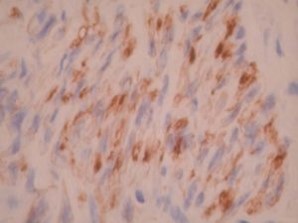Caldesmon by IHC
Caldesmon by IHC-12376 - Technical only, 12379 - Technical & interpretation
Caldesmon by IHC
12376 - Technical only, 12379 - Technical & interpretation
LAB12376
LAB12379
LAB12379
h-caldesmon
- All IHC stains will include a positive control tissue
- The primary use for this antibody is in identifying cells and tumors of smooth muscle origin
- Caldesmon will react with leiomyomas and leiomyosarcomas
- This antibody has not been found to significantly react with tumors of skeletal muscle or myofibroblastic origin (less than 1% of cells in MFH tumors have shown some staining)
- This marker will also react with glomus tumors
- Caldesmon will react with benign myoepithelial cells, however neoplastic myoepithelial tumors and mixed tumors of salivary gland and skin show no reactivity
- This antibody has also been used to identify the myoepithelial layer surrounding benign breast proliferations (can be used as an adjunct to SMMS)
Tissue
Submit a formalin-fixed, paraffin embedded tissue block
Formalin-fixed, paraffin embedded (FFPE) tissue block
FFPE tissue section mounted on a charged, unstained slide
Ambient (preferred)
- Unlabeled/mislabeled block
- Insufficient tissue
- Slides broken beyond repair
AHL - Immunohistochemistry
Mo - Fr
1 - 2 days
Immunohistochemical staining and microscopic examination
If requested, an interpretive report will be provided
Specifications
- Caldesmon is a protein which is reported to be specific for smooth muscle cells
- The h-isoform (this antibody) identifies only vascular and visceral smooth muscle cells; the l-isoform (which our antibody does not recognize) is found in many other kinds of cells
- It combines with calmodulin, tropomyosin, and actin and is thought to regulate cellular contraction
- Caldesmon has not been identified in skeletal muscle
Staining pattern
- Cytoplasmic based activity
References
- Ceballos KM et al. Is anti-h-caldesmon useful for distinguishing smooth muscle and myofibroblastic tumors? An immunohistochemical study. Am J Clin Pathol, 2000,; 114:746-753.
- Watanabe K et al: H-caldesmon in leiomyosarcoma and tumors with smooth muscle cell-like differentiation: its specific expression in the smooth muscle cell tumor. Hum Pathol, 1999,; 30:4; 392-396.
- Wang NP et al: Antibodies to novel myoepithelium associated proteins distinguish benign lesions and carcinoma in situ from invasive carcinoma of the breast. Appl Immunohistochemistry 1997; 5(3) 141-151.
88342 - 1st stain
88341 - each additional stain
88341 - each additional stain
10/25/2017
10/17/2018
01/12/2024
